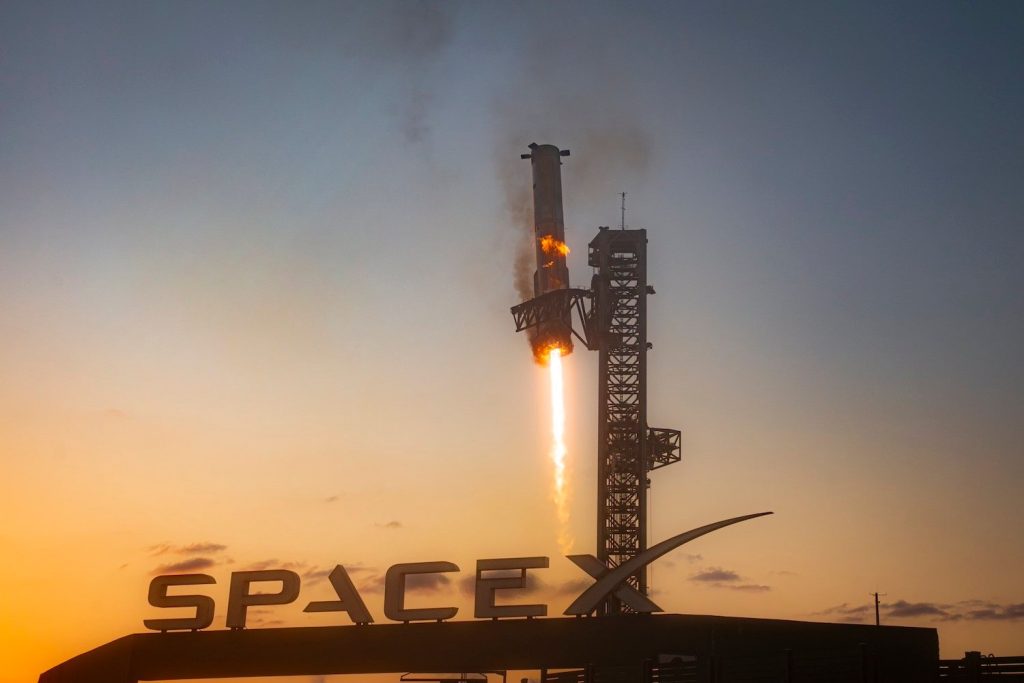Following a groundbreaking test flight of Starship in which the booster was caught mid-air by a huge metal tower, SpaceX is already planning on doing the same for the rocket’s upper stage to make way for full reusability of its heavy launch vehicle.
Starship lifted off on Sunday, October 13, at 8:25 a.m. ET from SpaceX’s Starbase facility in Boca Chica, Texas for the rocket’s fifth test flight. For the first time, the rocket’s Super Heavy 232-foot-tall (71 meters) booster gently came down towards a special launch tower, which caught the massive launch vehicle in its arms like a kangaroo stuffing its baby in its pouch. Meanwhile, Starship’s upper stage completed its flight with a controlled splashdown in the Indian Ocean, landing precisely near a buoy, or some kind of floatation device, equipped with a camera.
“Starship flip maneuver and landing burn on its fifth flight test,” SpaceX wrote in a post on X on Friday, sharing a video of the upper stage splashdown. “Vehicle improvements ensured flaps were protected from high heating, resulting in a controlled entry and high-accuracy splashdown at the targeted area in the Indian Ocean.”
Starship flip maneuver and landing burn on its fifth flight test. Vehicle improvements ensured flaps were protected from high heating, resulting in a controlled entry and high accuracy splashdown at the targeted area in the Indian Ocean pic.twitter.com/nLIQLLVMv1
— SpaceX (@SpaceX) October 18, 2024
The 165-foot-tall (50 meters) upper stage, however, isn’t doomed for late-night swims while the booster gets all the attention. SpaceX is planning on catching Starship’s upper stage, also known as Ship, using the same bold maneuver as early as next year. “Hopefully, early next year, we will catch the ship too,” SpaceX founder and CEO Elon Musk wrote on X.
“Starship achieved a precise, soft landing in the ocean, paving the way for return to launch site and being caught by the tower arms, like the booster,” Musk elaborated in a later post on Friday. “Full & rapid reusability improves the cost of access to orbit & beyond by >10,000%. It is the fundamental technology breakthrough needed to make life multiplanetary and for us to become a true spacefaring civilization.”
It seems like an achievable goal considering how far the company has come in pushing the boundaries of its rocket with each test flight. SpaceX launched its Starship rocket for the first time in April 2023, but its debut was less than ideal as the vehicle entered into a fatal tumble that forced ground controllers to issue a self-destruct command right before the four-minute mark of the mission.
In November 2023, Starship’s second test flight resulted in the in-flight destruction of both the Super Heavy booster and upper stage, but it was still a major improvement from its inaugural flight. For the third test flight in March, Starship successfully performed a stage separation, completed a full-duration burn of the second-stage engines, demonstrated internal propellant transfer for NASA, and tested the Starlink dispenser door. Starship’s fourth liftoff in June broke new grounds compared to its previous test flights, with the rocket largely surviving peak heating and max aerodynamic pressure during its controlled reentry.
The most recent test flight exceeded all expectations with an incredible feat of engineering that paves the way for the rocket’s upcoming missions. Ultimately, SpaceX plans on retrieving and reusing both Starship’s booster and its upper stage, but it has more experience landing boosters. The company’s workhorse Falcon 9 rocket booster has been recovered more than 300 times since its debut in 2010.
SpaceX has previously tested the landing capabilities of Starship’s upper stage, which is also designed to land on its own similar to the Falcon 9 rocket. Between December 2020 and March 2021, SpaceX conducted high-altitude flight tests of Starship prototypes SN8 through SN11 from Boca Chica, Texas. SN8 and SN9 reached their target altitudes but crashed upon landing due to technical issues. SN10 successfully landed but exploded shortly after due to damage from a hard landing. SN11, the final test of the prototypes, also ended with a big crash.
SpaceX has big plans for Starship, hoping it will be ready in time to launch NASA’s Artemis 3 mission in September 2026, and possibly deliver the first human missions to Mars in the near future. The vehicle’s upper stage needs to be capable of performing a pinpoint landing on the lunar surface, and even the dusty Martian surface at some point, but catching it with the Mechazilla tower on Earth could help improve its chances of reusability.
So far, the company has been making headway with its Starship rocket, and we’re excited to see what’s next.

